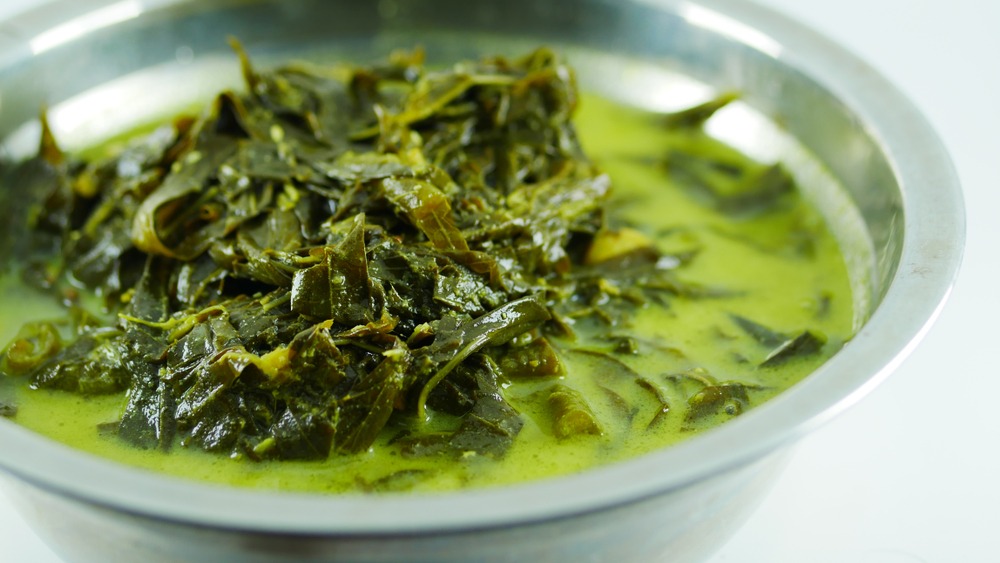Matapa: Mozambique’s Culinary Heartbeat
At the intersection of tradition and taste in Mozambican cuisine, you’ll find Matapa. A stew, yes, but also a symbol of Mozambique’s culinary legacy, this dish echoes the whispers of ancestors, the rustling of cassava leaves, and the gentle lapping of waves on Mozambique’s pristine shores. Made primarily from cassava leaves, groundnuts, and coconut milk, Matapa is more than a dish—it’s a narrative of resilience, tradition, and communal unity.
From Ancestral Pots to Contemporary Kitchens: The Tale of Matapa
Matapa’s roots delve deep into Mozambique’s agrarian past, a time when meals were a testament to the land’s bounty. Cassava, introduced to Africa hundreds of years ago, found its place in Mozambican soil and heart. Over generations, what began as a simple peasant dish has transformed, incorporating influences from trade, colonization, and local innovation, resulting in the richly layered Matapa stew we know today.
The Mosaic of Flavors: Crafting the Perfect Matapa
Matapa’s brilliance lies in its symphony of simple ingredients, each playing a crucial role in the melody of flavors.
- Young cassava leaves, meticulously pounded into a smooth paste
- Rich coconut milk, squeezed from freshly grated coconuts
- Ground peanuts or cashews, lending depth and nuttiness
- Fresh seafood, often prawns or clams, bringing a touch of the ocean
- Garlic, onions, and peppers, forming the aromatic foundation
Assembling Matapa is akin to weaving a tapestry. Begin by sautéing the aromatics, introducing the cassava paste and letting it simmer gently. As it thickens, the nut paste and coconut milk meld into the stew, creating a creamy, rich base. Finally, seafood is nestled in, absorbing and adding layers of flavor.
Beyond the Stew: Matapa’s Place in Mozambican Culture
Any Mozambican will attest: Matapa is not just food; it’s an emotion. It’s the dish around which families gather, stories are shared, and bonds are strengthened. It graces both everyday tables and festive feasts, symbolizing unity and shared heritage. In rural settings, the act of preparing Matapa, from harvesting cassava to the communal cooking, reinforces community bonds and passes on traditions to younger generations.

Savoring Matapa: The Traditional Way
While Matapa is a feast in itself, it’s traditionally paired with rice or xima (maize porridge), which complements its creamy consistency. A dash of fiery piri-piri sauce on the side elevates the experience. As you dive into a bowl of Matapa, you’re not just tasting a stew; you’re partaking in a centuries-old Mozambican tradition.
Navigating the Depths of Matapa: Common Questions
1. Is there a vegetarian version of Matapa?
Indeed, while seafood is a common addition, many households prepare a purely vegetarian Matapa, letting the flavors of cassava, coconut, and groundnuts shine.
2. How long can Matapa be stored?
Matapa tastes even richer a day after cooking, with flavors melding beautifully. It can be refrigerated for up to 3 days. Warm before serving for the best experience.
3. Can I use frozen cassava leaves?
While fresh leaves are ideal, frozen cassava leaves, available in many African grocery stores, are a worthy substitute.
4. Is there any alternative to cassava leaves in the recipe?
Traditionally, cassava leaves are integral to Matapa. However, in their absence, spinach or collard greens can be used, though the taste will differ slightly.
5. What’s the significance of using young cassava leaves?
Young cassava leaves are tender and have a milder flavor, making them ideal for the soft, creamy consistency of Matapa.
Having tasted the cultural essence of Matapa, there’s a whole array of Mozambican delights waiting to be explored. Dive into the authentic tastes of Mozambique and enrich your culinary repertoire.
